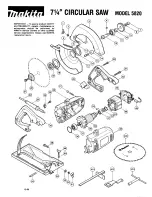
32
h)
Do not let familiarity gained from frequent use of tools allow you to become complacent and
ignore tool safety principles.
A careless action can cause severe injury within a fraction of a second.
4. Power tool use and care
a)
Do not force the power tool. Use the correct power tool for your application.
The correct power
tool will do the job better and safer at the rate for which it was designed.
b)
Do not use the power tool if the switch does not turn it on and off.
Any power tool that cannot be
controlled with the switch is dangerous and must be repaired.
c)
Disconnect the plug from the power source and/or the battery pack from the power tool before
making any adjustments, changing accessories, or storing power tools.
Such preventive safety
measures reduce the risk of starting the power tool accidentally.
d)
Store idle power tools out of the reach of children and do not allow persons unfamiliar with the
power tool or these instructions to operate the power tool.
Power tools are dangerous in the hands
of untrained users.
e)
Maintain power tools. Check for misalignment or binding of moving parts, breakage of parts and
any other condition that may affect the power tool’s operation. If damaged, have the power tool
repaired before use.
Many accidents are caused by poorly maintained power tools.
f)
Keep cutting tools sharp and clean.
Properly maintained cutting tools with sharp cutting edges are
less likely to bind and are easier to control.
g)
Use the power tool, accessories and tool bits etc. in accordance with these instructions, taking into
account the working conditions and the work to be performed.
Use of the power tool for
operations different from those intended could result in a hazardous situation.
h)
Keep handle dry, clean and free from oil and grease.
Slippery handles do not allow for safe handling
and control of the tool in unexpected situations.
5. Service
a)
Have your power tool serviced by a qualified repair person using only identical replacement parts.
This will ensure that the safety of the power tool is maintained.
ADDITIONAL SAFETY RULES FOR JIG SAW
Hold the electric tool by the insulated handles when you are carrying out work during which the
electric tool may come into contact with concealed power cables or its own power cable.
Contact with
a live cable may also cause metal parts of the appliance to become live and lead to electric shock.
Keep your hands away from the sawing area. Do not reach underneath the workpiece.
Contact with
the saw blade may result in injury.
Keep your hands away from the stroke rod and the quick-release chuck.
Contact with these
components may result in a crushing injury.
Always switch on the electrical power tool before applying it to the workpiece. Otherwise, there is a
risk of a kickback.
When sawing, ensure that the baseplate is in contact with the workpiece.
After completing your work, switch the electric tool off and do not pull the saw blade out
of the cut until the tool has come to a standstill.
This avoids kickbacks, and allows you to put
the tool down safely.









































